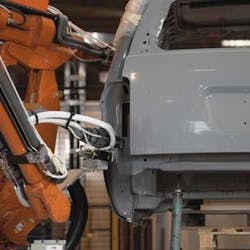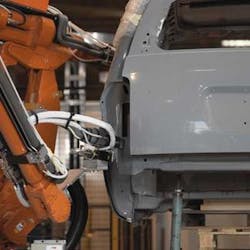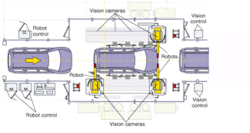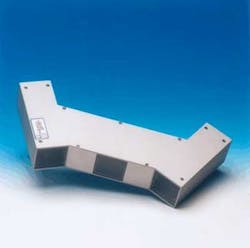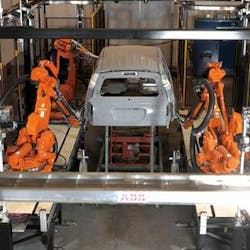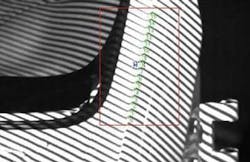Vision-guided robotics speeds foam dispensing
By Kevin Taylor
Liquid-polyurethane foam hardens into thermal insulation after it comes into contact with the air. Homeowners use it to insulate pipes and fill holes around conduits as they pass through walls, floors, and ceilings. Automotive manufacturers use a similar, two-part foam product to dampen the sound inside a vehicle’s cab.
Working with ABB Robotics and ISRA Vision Systems, an automaker recently automated the first foam-dispensing work cell on its new sports-utility-vehicle (SUV) manufacturing line. Previously, production-line workers manually dispensed the foam into vehicle pillars inside the car body, doors, fenders, and other cavities by lifting a heavy dispensing gun, putting it in an access hole, and pulling the trigger up to a dozen times per vehicle.
In addition, clogged dispensers were common, slowing down the process. Engineers designing the line and car assembly had to set up the station so that the access holes in the car body were below the operator’s waist because the heavy dispensing gun could become an occupational hazard, which limited where the foam could be placed inside the car. Also, foam dispensing was not standardized, and quality was an issue.
ABB designed a paint-shop-type robot work cell that uses three articulated IRB 4400 L-i10 robots equipped with ABB S4Cplus+ robot controllers, one located on each side of the line, for easy maintenance. The robots, two located on one side of the line and one opposite, are mounted on tracks to provide a seventh axis of movement (see Figs. 1 and 2).
Robot guidance is provided by three vision-integrated, assembly-measurement-system (VIAMES) image-processing controllers attached to 12 dual-camera location-measurement stereovision sensors (LOCMESs), with a maximum of four per VIAMES controller. The LOCMES stereovision systems come with an integrated halogen stripe-light source composed of a halogen light and optical grating for projecting “light stripes” that image-processing algorithms can use as additional image features to improve the accuracy of the three-dimensional (3-D) coordinates on highly reflective surfaces, such as car bodies (see Fig. 3).
Coming down the line
In operation, a car body comes down the production line on a high-speed belt transfer until it reaches a skid stop station in the middle of the foam-dispensing work cell. The skid supporting the body is lifted hydraulically into place (see Fig. 4). Contact sensors notify the Allen-Bradley PLC-which acts as the main controller and operator interface for the foam-dispensing work cell-that the body is in place.
Via the DeviceNet plant network, which acts as the communications backbone for the vision and robot controllers as well as the supervising PLC, the PLC passes along a start message to the VIAMES machine-vision controller. The VIAMES controller houses a DeviceNet network card that accepts the trigger signal along with an identification code that tells the vision system which SUV style is in the work cell.
The VIAMES controller is an industrial PC running Windows 2000 with a Pentium processor and at least 1 Gbyte of RAM for buffering image data. Each of the 12 LOCMESs contains two ISRA 8-bit, 768 * 576-pixel, FZK-2098 cameras with RS-422 output. Image data are multiplexed and transmitted back across a single BAS-type connector to an ISRA PCsmile frame grabber with on-board image processing. ISRA BrainWARE software running on the VIAMES PC takes the images and uses normalized correlation to identify features in the image, such as the access hole and “light stripes” that act as additional features for 3-D data extraction when curved or reflective body panels make such a determination difficult (see Fig. 5).
Because of the fixed position of the cameras relative to the car body and access holes, ISRA was able to use normalized correlation rather than geometric pattern-matching to locate the features in an image. Normalized correlation offers better robustness in changing plant-lighting conditions and transient noise caused by factors such as debris and dust, and is much faster than geometric searches, which is important when multiplexing eight cameras (four LOCMESs) to a single PC.
After sufficient features are located in the image data, VIAMES calculates the offset between similar features in separate images from each of the cameras in one LOCMES sensor. These data provide the basis for a triangulation function that generates 3-D data on the location of the car panel and access hole with six degrees of freedom.
The robot positions itself to a zero point in rough alignment to the panel access hole based on CAD-based information stored in the ABB Flex UI robot controller, and then the offset coordinates provided by the VIAMES controller across the DeviceNet network and Allen-Bradley PLC guides the Gusmer Beta Cell 241 and GX15 foam-dispensing gun attached to the robot arm to the first 12-mm access hole for filling.
The dispensing nozzle is 11 mm in diameter, while the access holes are 12 mm in diameter; therefore, the ISRA system must locate the access hole within 0.5 mm for a good fit. The Gusmer dispensing-gun nozzle is spring loaded with a force-feedback sensor tied into the ABB FLEX robot controller so that a tight seal is verified before dispensing the foam into the cavity. This design cuts down on spillage and waste in the work cell.
The ABB controller tells the Gusmer gun how much foam to dispense for the specific vehicle feature being addressed. The exact amount is dispensed before the robot withdraws the nozzle, and the PLC triggers the VIAMES controller to query the next LOCMES in line. Offsets from the next LOCMES provide coordinates for the next hole.
An SUV can have up to 14 access holes, depending on the body model. After each car is completed, the ABB controller directs the robot to clean the gun tip at a nearby station, eliminating clogged nozzles caused by inadequate cleaning.
Since installing the new foam-dispensing cell, the automaker claims uptime in the high 90%, which is more than 5% higher than uptime predictions. According to ABB Robotics, it is developing a multiple-vehicle platform solution so this technology can be easily adapted to existing plants that currently use foam in their manufacturing process.
Kevin Taylor is national sales manager, ISRA Vision Systems, Lansing, MI USA; www.isravision.com.
Company Info
ABB Automation Technologies, Robotic Products Auburn Hills, MI, USA www.abb.us
Gusmer Corporation Lakewood, NJ, USA www.gusmer.com
ISRA Vision Systems, Lansing, MI, USA www.isravision.com
Rockwell Automation Milwaukee, WI, USA www.rockwellautomation.com
